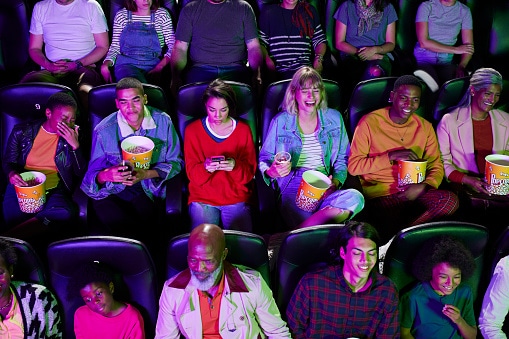They’re all closed.
Movie Theaters. Bars. Nightclubs. Arenas. Cafes. In New York, Broadway and museums are shuttered. In San Francisco it’s even more dire. Across the country and the world, cities are shutting down, leaving humans from Seattle to Shanghai without traditional ways of finding distraction.
The mandate for social distancing that has proven essential at slowing the spread of the coronavirus will cut about $12 billion of entertainment revenue from the U.S. if the shutdown lasts until July, as President Trump signaled. Billions more are not being spent on creating new content as film and television production is frozen.
Things could get a lot worse.
“This is definitely unprecedented and turning everyone’s lives completely upside down,” says Ryan Borba, managing editor at concert tracker Pollstar.
Loading...
The concert and live event industry brought in $34 billion last year, according to market research firm IBISWorld. Simple math suggests that a three-month shutdown at this time of year could cost that industry $7 billion of lost revenue. Any longer and it starts to cut into the popular summer concert season, which for LiveNation, the world’s biggest concert promoter, is when 70% of its attendance begins passing through the turnstiles. That’s bad news for the producers, songwriters, technicians and the 269,025 concert employees, including janitors, security personnel and ticket collectors. That’s not to mention the world’s top-earning musicians, all of whom make the majority of their money performing.
“We’re beginning to see it affect the entire music ecosystem,” one prominent artist manager who told Forbes on the condition of anonymity. “We’re getting calls from our agents about promoters canceling individual shows. Songwriters and producers have canceled flights into L.A. for sessions, so it’s starting to trickle down to the songwriting and production communities as well.”
On New York’s Broadway, where all 41 theaters are closed, the hit could be about $600 million, based on the amount they pulled in between mid March and July of 2019. During the 2016-2017 season, those theaters also supported more than 87,000 jobs and contributed $12.63 billion to New York City’s economy, according to Broadway League.
The effect on movie theaters is far more drastic. A complete shutdown across the U.S. will mean a $4 billion hit on the box office if they remain closed until July. On March 18, less than a month into the crisis, the national association of theater owner requested a bailout from the government.
“From the point of view of studios they are hemorrhaging money on the movie side,” says Mike Bloxham the senior vice president of global media and entertainment at research firm Magid. “There is a lot of money disappearing in China while 70,000 theaters are still closed.”
Once they do reopen, distributors will begin battling to squeeze a large number of films into a limited number of opening dates, including some major releases that include the latest James Bond movie, Disney’s Mulan and Marvel’s Black Widow, all of which have been pushed back.
“No one can precisely predict when public life will return to normal, but it will return,” Patrick Corcoran, the president of the National Association of Theater Owners, said in a statement on Match 17. “When those titles are rescheduled, they will make for an even fuller slate of offerings than normal as they are slotted into an already robust release schedule later in the year.”
Last year, entertainment companies spent $121 billion to create original content and they were expected to spend even more this year as new platforms, like short-form video platform Quibi, emerge and streaming giants like Netflix and Amazon Prime continue to plow through cash to produce new shows that lure in subscribers. Disney, Netflix, Universal and a number of other studios have all but shut down U.S. production. In California alone, that activity supported more than 722,000 jobs and $68 billion in wages, according to the Motion Picture Association of America. In New York City, television and film production support about 10% of total employment, whether directly or indirectly, and generates almost $9 billion each year.
“Right now, we’re working to keep everyone safe, support the industry and find ways to help it come back stronger than ever,” a spokesperson for Mayor’s Office of Media and Entertainment said.
The sentiment mirrored that of Colleen Bell, the executive director of California’s Film Commission who said, “The entertainment production industry in California has overcome challenges in the past, and it will endure this sudden shutdown. Until the COVID-19 situation improves, the focus is rightfully on the public health crisis. After that’s behind us, the industry will once again thrive here in the Golden State.”
While those logistics will reverberate widely across show business sectors, consumers may be in for even bigger, long-lasting changes.
For TV shows, the near-term effects could be disappointing for fans looking forward to fresh episodes of their favorite shows. FX’s Fargo has shut down production and will have to delay new episodes. More series are sure to follow. Streamers have already changed the way we watch TV—introducing binge-watching and slowly eliminating cable subscriptions—and the more that cable and broadcast series are delayed, the more likely we will continue to move away from the appointment viewing of television’s past.
In film, a far more dramatic shift just happened: consumers may no longer need to fight crowds at movie theaters on opening nights. Universal Studios announced Monday that it would begin releasing films like Invisible Man, Emma and The Hunt available for in-home, on-demand rentals despite the fact that these films were only recently released, blowing up the entrenched windowing schedule that gave theater chains exclusive rights to show movies first before they were released to in-flight entertainment, rental platforms and then television. Sony followed, releasing Vin Diesel’s Bloodshot for digital purchase only 11 days after its theatrical release.
Others will likely do same and if they do, it could lead the Academy of Motion Picture Arts and Sciences to change their theatrical-release rule, which only allows films that open in a theatre and stay there for seven days to be considered for Oscars. It may also prompt Netflix to tighten its grip on the entertainment business with the purchase of a theater chain of its own. In 2018, the streaming giant looked at buying Landmark Theatres, but Cohen Media Group beat Netflix to the arthouse chain.
“If this continues for a long time, that will cause a change in how we consume content and allow newer titles to get to home video much faster,” says Asaf Ashkenazi, the COO of Verimatrix, a technology company that works with distributors in Hollywood. “If it’s a new title, you can delay it, continue to follow the traditional system and just wait. Or you can be more experimental and go directly to selling or renting online, which will allow more people to access it and get the revenue now.“
Other businesses are also turning to streaming, including concert-streamer StageIt. The startup, which offers concerts from the likes of Jon Bon Jovi and Sara Bareilles, is on track to have revenue of $250,000 this week—about the same as its best month until now—and added 10,000 subscribers in two days while hosting virtual festival “Shut In & Sing.” Even New York’s Metropolitan Opera is in on it, streaming nightly performances.
The stars themselves are also shifting their approach to how they entertain and communicate with fans. “Together, at Home,” a new series of online concerts presented by the World Health Organization (WHO) and Global Citizen, has recruited Chris Martin and John Legend to give casual concerts from their living rooms via Instagram Live, taking requests from fans and singing songs like David Bowie’s “Life on Mars.” Using Instagram, pop star Lizzo led a meditation, Frozen’s Josh Gad read kids a story, and, on Twitter, Yo-Yo Ma played a “song of comfort.” Entertainers have already fully embraced this kind of direct connection with fans and the pandemic may only accelerate that.
–Madeline Berg, Forbes Staff, Media
Loading...





















